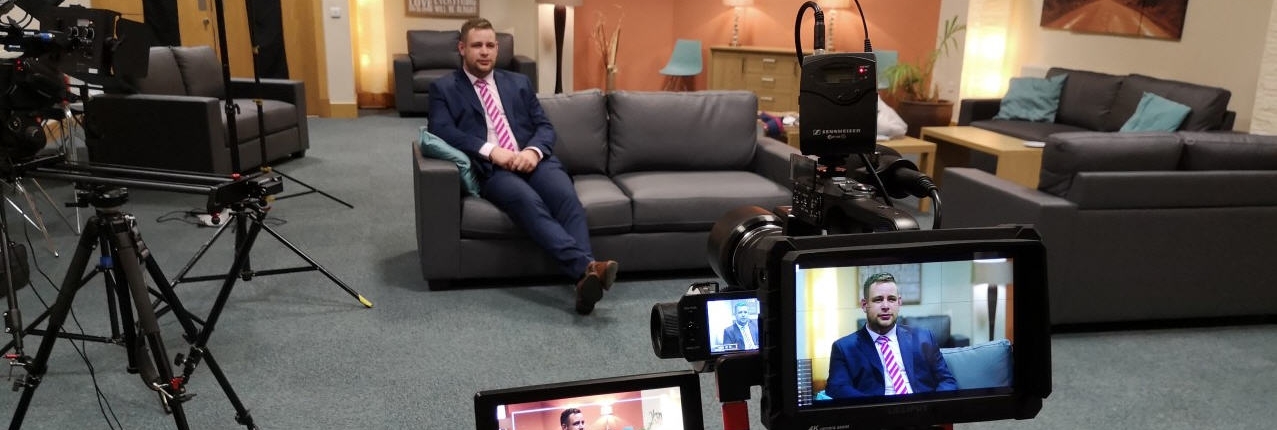There are a small number of people who love talking on camera. The rest of us (including myself) only talk on camera when it’s mission critical. In these current times, people like being informed through video, so performing on camera has become a valuable business skill.
If you will be talking on camera for your business or charity then here are some tips to help you work it like a pro.
Do research
Talk to the production crew or whoever is responsible for filming before the day. If it’s an in-house filming project, talk to the person responsible for the shoot. Find out the format and how the day will run. This will not only enable you to understand what will happen but will also help build rapport with the crew. Both of which will set you up to be more relaxed during filming.
Check the basics such as start and end time, location, and content requirements. You might want to know if you will be sitting or standing, especially if it will be all day.
Establish what the dress code is, should it include corporate branded tops, formal or casual clothing? When being filmed it’s best to avoid clothing with small repeat patterns or fine stripes. It’s also best to avoid wearing the same colour top as the background, especially if that’s white. Whatever you end up wearing on camera, make sure it’s something you are comfortable with. It won’t look great if you are adjusting your collar (for example) all through the filming.
Avoid items of clothing or jewellery that make a noise as you move. The noise will be picked up by the mic and end up distracting viewers from your message.
Check if you will be talking to camera or looking off-camera to an interviewer. If you are delivering to an interviewer, don’t look at the camera. If you do you will be breaking the principle of the “4th wall”.
If the content needs to be worded accurately (such as in the financial services sector) it can be helpful to have someone from compliance listen to the delivery. This way, any errors can be corrected with a retake before the filming day is finished.
Is there going to be any “B” roll footage that will be included in the final film? “B” Roll is footage in addition to the presentation that illustrates the message. It could include; processes, people working or the work environment. This can enable the film editor to have a lot more scope to correct the audio delivery, as the cuts in the video will be covered by the “B” roll footage.
Be prepared
If you will be reading from an Autocue, read through and check you are happy with the content a few day’s beforehand. If you are not experienced reading from an Autocue, you might want to download a free app to practice ahead of filming. This could include recording yourself with a phone camera to critique your delivery. Even if you don’t record yourself, it’s still important to read the script out loud, it’s the only way to practice the flow of the script and also for accurately assessing the run time.
If you use glasses (or preferably contact lenses to avoid reflections) ensure you have them to be able to read the text from a distance of approximately 4 metres.
Check where the cut-off is for each camera framing. It’s helpful to be aware if your hands or even feet will be in the shot -especially if you have a tendency to move them in a way that could be distracting to viewers.
Remove lanyards or name badges as they not only look messy on camera but can also reflect the film lighting into the lens.
If you are delivering several videos to be released over a staggered timescale; you might want to have some alternative outfits so you have a different look in each video.
In saying that, it is important to be aware of continuity issues if a film is to be watched in one sitting. For example, a classic continuity error is removing a jacket or pair of glasses partway through the filming. In the edit, the item suddenly disappears and may even reappear again, very distracting and not very professional.
Quick Wins
Here is some of the most common advice that we share during filming.
Relax! You are not expected to act out of character, put on a posh voice or become unrecognisable, people want to see you being YOU.
Have a practice in front of the cameras and lights. This helps you relax before the recording starts.
Don’t start every sentence with the word “SO”.
Slow down! Most people talk too fast and get tongue-tied. It helps the words to come out more accurately if the pace is correct.
Don’t move your hands just because you think you should. It can look very unnatural unless the movement is helping to express a point.
Remember you have been asked to talk because you are the expert and your opinion matters.
Be concise, don’t over-explain.
Don’t worry if you make a mistake, most people do, you can try again until you’re happy with the result.
At the end of the filming, record your opening section again. People always relax as they spend more time in front of the cameras so this will give you a more relaxed opening line than the original.
Be open to feedback and advice from the crew. They will have lots of experience at getting the best results from clients and should be more than happy to share it with you.
If you have any questions regarding filming please feel free to contact me for a chat. David Bird.







